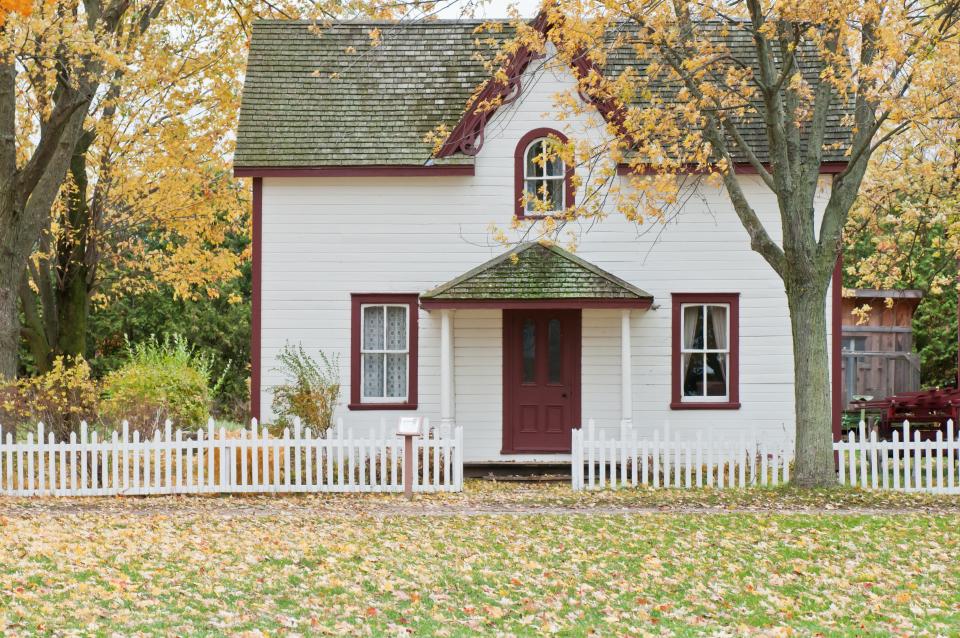Have you always wanted to surround your home with a quaint picket fence? You may have felt hesitant because of the cost or how long it will take, but the truth is that you can create a DIY picket fence in just a couple of days! This DIY fence guide will walk you through creating your own picket fence using products and materials of your choice. It’s easy, cost effective, and will give your home a touch of classic beauty.
What You’ll Need

Before you begin your DIY project, there are some tools and materials you’re going to need. To start, you’ll need a fence calculator. This handy tool is a must-have before you buy or build a fence. It’s a sure-fire way to determine how much material, such as fence sections, posts, hardware, concrete, post caps, gates, and more that you may need to complete your fence installation. In addition to your fence calculator, you’ll need the following:
- Post Hole Digger
- Plumb Bob
- Line Level
- Hammer
- Electric Drill w/ Screwdriver Attachment
- String
- Fast-setting Concrete
- Wooden Stakes
- Paint
- Gravel
- 2” Galvanized Screws
- 1-1/2” Galvanized Screws
- 4×4 Wooden Posts (Cedar or Your Choice)
- 1×4 Wooden Pickets (Cedar or Your Choice)
- 2×4 Wooden Railings (Cedar or Your Choice)
Step by Step

Now that you’ve got your materials, this guide will take you through creating your own DIY picket fence step by step. Be sure to read and reread directions as you go along to make sure everything is done right the first time. This will save you from having to redo steps or even start the project over completely.
Step 1: Plotting out the Fence Outline
Plotting the fence outline simply means finding where you want your fence to go. Once you identify the perfect spot, drive temporary stakes at all the corners of the outline. Take the string and stretch it between the stakes, ensuring that the lines are tight, square, and making sharp angles. Use the spray paint to mark locations for the posts, taking care to space them up to 6-8 feet apart. To play it safe, check and recheck measurements before making permanent marks.
Step 2: Making Postholes and Setting Fence Posts
At each of the marked locations (corners included) dig post holes at least two feet deep. If you can secure one, a power auger is a great tool to use to cut digging time in half. Once the holes have been dug, add 3” of gravel to the bottom of the hole. This will help with drainage during wet weather, from sprinklers, or water play. Pack gravel in with the posts, and then place the posts in the holes. Make sure the posts are as level and upright as possible. From here, fill the hole with the fast setting concrete to at least 2” above the ground level. Allow the concrete to slope a bit to avert water. Pause and check that the posts are still standing straight and plumb. Finally, brace posts with the stakes so make sure they’ll stay straight while they set.
Step 3: Attach the Top and Bottom Railings
Once the posts have set, measure the space between the posts and cut 2” by 4” wooden railings to length. Attach the bottom railings to the fence post using the galvanized screws and nails. Attach at least 6” up from the grade. Next, attach the top railings to the fence posts about 6” below the top of the pickets. Remember, make sure both the top and bottom railings are level before making permanent attachments.
Step 4: Attach Pickets to Railings
Thanks to your fence calculator, you already know how many pickets you’ll need for your fence. Cut the pickets to length creating your own design or using a precut design. Once you’ve got your pickets all laid out, determine how wide the spaces between them ought to be. If you want your pickets to cover the posts, measure accordingly. If you don’t want your pickets to cover the posts, try leaving half a space next to the posts before placing the next picket on the railings. When attaching pickets to the railings, use the galvanized screws, nails, and electric driver to make sure everything is sturdy and secure. Always measure before attaching the next picket to make sure that the spacing is consistent. A spacer block is a great tool to keep measurements accurate.
Once the pickets are attached, apply your choice of paint or color stain to help protect the finished fence from the elements.

There you have it—creating a DIY picket fence is really just that easy! Raise property value, curb appeal, and personal satisfaction with your home by taking on this great project. The whole thing takes about two days, tops, so you can complete it in a weekend or whenever you have some unfettered time. Your picket fence will certainly add the touch of quaintness and class to your home, and you’ll love the fact that you were able to do it all on your own. Happy building!


Thanks for the great step by step instructions. Should make installing a fence much easier